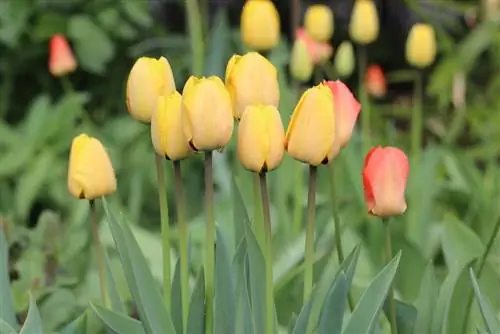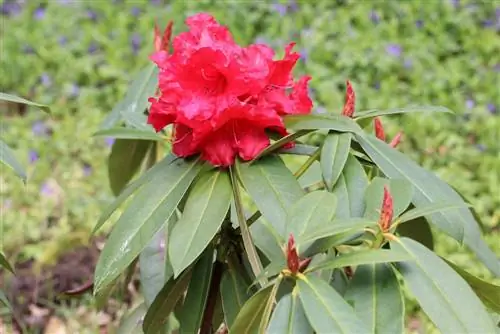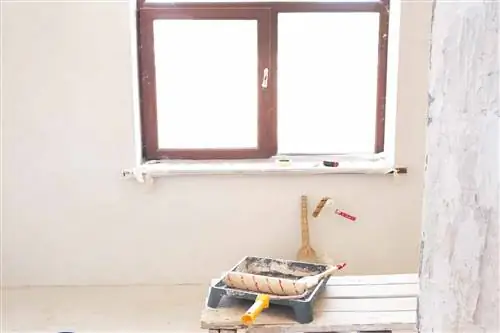- Author admin [email protected].
- Public 2023-12-17 03:39.
- Last modified 2025-06-01 06:48.
They come in every flower shape and color imaginable: tulips. From March to May we can enjoy the beautiful flowers every year. The elegant plants belong to the lily family and with the right care, the owner can enjoy them for a long time. Whether the plant blooms every year or “takes a break” depends on the respective variety - and also on the correct care.
Profile - Tulip (Tulipa):
- Height: 10 - 60 cm (depending on the variety)
- Flowering time: Spring (March to May)
- Location: sunny to partially shaded
- Watering: the soil should be moist but never wet
- Soil: humus-like, loose
The Tulip Bulb
Tulip bulbs are available in all shapes and colors every year from September onwards. When buying onions, you should make sure that they are as large as possible. They should also be firm and have no soft or dark spots.
If the bulbs are not planted as soon as possible after purchase, they can be stored in a dark, cool and dry place. Storage should not be in closed bags or containers, otherwise there is a risk of mold due to moisture.
In general, however, the sooner the onion is planted, the better, as it has more time to absorb nutrients.
The Location
Tulips prefer moist, humus-rich soil, but there should be no waterlogging. If the soil is dense, heavy, it is advisable to mix in some sand to loosen the soil and prevent waterlogging. If possible, the location should be sunny and warm; tulips also feel quite comfortable in partial shade; For most varieties, at least two, but preferably more, hours of sun per day are optimal. Care should be taken not to expose the tulip to strong winds, otherwise there is a risk that the stem will break. Choosing the right location is crucial for the longevity of the plants.
Planting tulip bulbs
Once the right location has been selected for the plant, the bulb can be placed in the ground. This should generally be done in late summer to fall. The bulbs should be placed in the ground with the tip upwards at a depth of around 10 - 15 cm and then loosely covered with soil. As a rule of thumb, the bulb should be planted at least twice as deep in the ground as it is high.
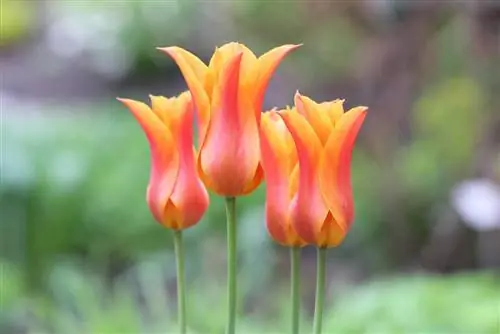
If several bulbs are to be planted, a distance of 5 - 25 cm must be maintained between them, depending on the variety. Planting bulbs should not be done during heavy rainfall. A temperature of 10-12°C is optimal so that the onion can develop roots before winter.
Fertilize
Tulips can be fertilized with horn shavings and other organic fertilizers. Fertilizing is not necessarily necessary, but can contribute to large flowers and more intense colors. If the soil is loose and nutrient-rich to begin with, there is no need for any fertilizer. When fertilizing, the following applies: less is more!
Care after flowering
Once the plant has finished flowering, the leaves should not be cut off immediately. Only when the leaves are really wilted can they be removed safely. Until then, they continue to be an important source of nutrients for the onion. The withered flowers should also be removed.
Wintering
Tulips can overwinter in the garden without any problems as long as they are planted deep enough. The onions are then usually safely protected from frost. However, it doesn't hurt to cover the bulbs with twigs or leaves over the winter. If that seems too unsafe, you can also dig up the onions and store them in a cool, dry place, for example in the cellar. It is particularly important to store the bulbs in a cool place, as the cooling process is essential for flower formation in spring. The dried leaves and flowers should be removed before storage.
In the fall, the bulbs can be put back into the ground. Depending on the variety, they will bloom as beautifully next year as they did the previous year; But it can also be that they only bloom again after two years.
After a few years, the flowering may decrease and the bulbs may need to be replaced with new ones. If the bulbs are not in the garden but in a flower box, they must be brought in for overwintering, as the amount of soil in a small flower box is not sufficient to protect against frost.
Diseases
Although it is extremely rare for tulips to be affected by diseases, it does happen sometimes. If a plant suffers from fungal infection (for example from onion rot or the so-called tulip fire), it and the immediate soil must be removed and renewed. An infestation of the onion can be recognized by reduced or even no flowering in spring.
Fungal infestation by soil fungi can be triggered, among other things, by temperatures that are too high at the time of planting; The result is that the onion rots.
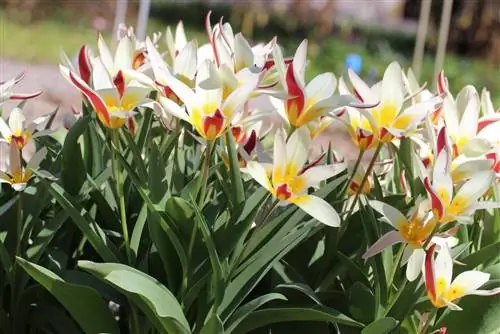
Another disease is the tobacco mosaic virus, which can be transmitted by aphids. If a few basic rules are followed, caring for the tulips properly is not difficult at all and the plants will thank you with colorful flowers.
They look particularly beautiful when planted in groups, as each of them only produces a single flower (apart from some special varieties).
Due to the many shapes and colors (around 3000 different varieties!) there are no limits to creativity when designing your home flower bed.
Tulips: flowering and care tips
Tulips show their beautiful flowers between February and June, depending on the variety. They are easy to care for and bloom in almost every location; It doesn't matter whether it's sunny, partially shaded or even shady, even if they prefer the sun. The onions are planted in September and that's pretty much it when it comes to care. Spent flowers should be removed before seeds form, but the stems should be left standing - as long as they do not disturb them.
Under no circumstances should you remove the leaves until they have dried out. This supplies the onion with nutrients and water and is the only way it can form daughter bulbs, which will then delight us with new flowers next year. Because the bulbs are used up through flowering and the formation of daughter bulbs, so tulips are considered annuals. They like a permeable, slightly humus-rich soil, but cannot tolerate any kind of waterlogging. Your water requirements are rather low.
Tulips as cut flowers
Most types of tulips are not particularly suitable as cut flowers because they do not last long. Cut flower food is absolutely necessary here and when buying, you should make sure that the bulbs are of good quality (not rotten, firm). Many sellers also specifically note on the packaging whether the variety is suitable as a cut flower.
- The fringed Crispa tulip Canasta is particularly worth mentioning. It reaches a height of 50 to 60 cm and has fiery red flowers fringed with white. With a flowering period from April to May, it is already one of the late-flowering varieties.
- The densely filled tulip beauty Angelique in soft pink is 40 cm high and is characterized by a long shelf life in the vase with a delicate floral scent.
- With a height of 45 cm, although smaller, but with a strong-growing style, the super tulip Gavota is definitely worth mentioning. The classic tulip-shaped flower is tricolor with burgundy red leaves with a white edge followed by a yellow stripe. It shows its extraordinary flowers from April to May and is considered a perennial bloomer.
- If you like pastel tones, the Dreamshow tulip is also a good choice as a cut flower. It blooms pink with yellow and white in April and grows to a height of 50 cm.
Popular wild tulips
Small wild tulips (botanical tulips) are particularly attractive. Their petals are more spread out than other tulip varieties.
- Here is impressive. B. the Tulipa tarda, which only grows to a height of 10 cm, with its beautiful yellow petals that are white on the outside.
- Or the Tulipa bifloriformis, which is much loved by bees, with its snow-white petals that spread wide apart and reveal the inner yellow calyx.
- The Tulipa humilis “Alba Coerulsea oculata”, which grows to a height of 10-25cm, is particularly beautiful. This tulip rarity, which blooms in March, impresses with its white, slightly fanned petals and a violet-blue heart.
- The botanical wild tulip Praestans “Tub” is a true splendor for every herbaceous bed. Variety", which brings an intensely bright color to every spring bed with its fire-red 3-6 flowers per style from March to April.
There are some other multi-flowered tulip beauties, such as the bright pink Fringes Family that blooms in April. It has 5-8 delicately fringed flowers per style and reaches an impressive height of 40 cm. The white-pink flamed Cloud Nine aims just as high with 5-8 flowers per style.
Popular noble tulips
The densely filled noble tulips fall slightly out of their typical flower shape. Note here the pure white or carmine pink Elegance, as well as the yellow-orange double-double Beauty of Apeldoorn. Orange Princess is more of a coppery orange and produces huge flowers with a fascinating play of colors.
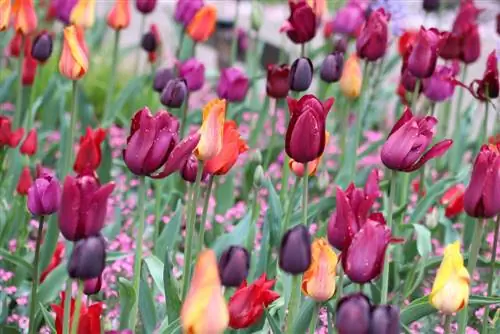
The most striking of all tulip varieties is certainly the double noble tulip Black Hero, which is an eye-catcher in every garden thanks to its elegant black flower color. But even in the classic tulip shape there is a night-black flower, that of the Queen of the Night. With its height of 60 cm, it is a perfect cut flower and impresses with its delicate, silky shine from April to May. The parrot tulips are a little more restless in terms of their petals but no less beautiful. One of the most impressive features here is the strikingly flamed yellow-orange-red Texas Flame, which delights in May with an unusually large flower calyx 50 cm high.
Whether in the garden, in perennial borders or in pots: Tulips particularly come into their own in small tuffs of around 10 to 20 plants. Daffodils and grape hyacinths prove to be good partners here.

